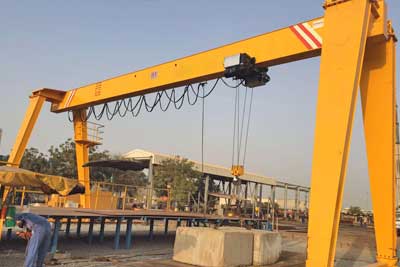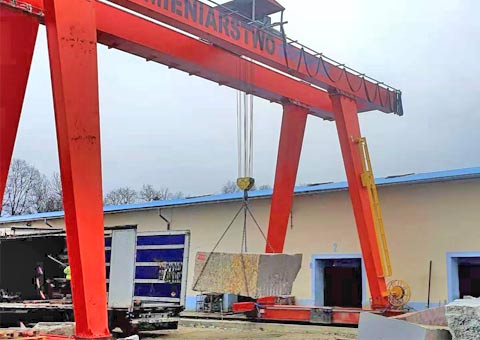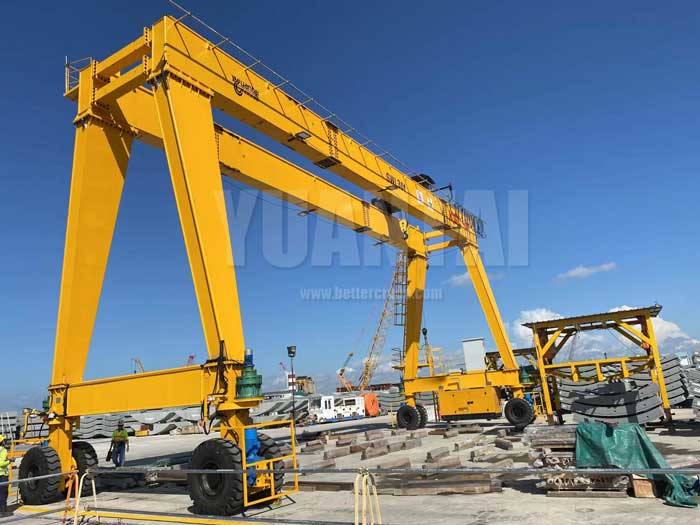Gantry Cranes for Handling Precast Tunnel Segments 30T, 40 T, 50 T to 150 Ton
Advancing Tunnel Construction: Specialized Gantry Cranes
The development and expansion of underground infrastructure projects have brought forth a crucial component—precast tunnel segments. These segments, meticulously designed and manufactured, form the backbone of tunnels, contributing to the efficiency and durability of underground structures. In this blog, we delve into the realm of specialized gantry cranes, engineered specifically for the precise handling and transportation of heavy precast tunnel segments.
The significance of gantry cranes in tunnel construction cannot be overstated. These specialized cranes play a critical role in ensuring the efficiency and precision required for handling precast tunnel segments. As we delve into the complexities of underground infrastructure, the weight and size of tunnel segments pose significant challenges. Gantry cranes emerge as the solution to these challenges, offering the strength and control necessary for seamless construction processes.
Types of Gantry Cranes Available for Tunnel Construction

Single Girder Gantry Cranes
Single girder gantry cranes are commonly used for handling lighter tunnel segments, but their utility extends beyond the tunnel construction industry. These cranes are equipped with a single beam spanning the width of the gantry, making them lighter and more cost-effective compared to double girder gantry cranes. They provide the ability to handle smaller loads with ease and efficiency.
In tunnel construction, single girder gantry cranes are ideal for transporting and positioning tunnel segments of moderate weight. They are particularly useful when working in confined spaces where maneuverability and flexibility are crucial. Their design allows for agile movement within limited spaces, making them suitable for navigating through the structural confines commonly found in tunnel construction sites.
Double Girder Gantry Cranes:
Double girder gantry cranes are specifically engineered to handle heavier loads and are particularly well-suited for large and robust tunnel segments. Due to their design with two beams spanning the gantry, double girder cranes provide enhanced stability and increased lifting capacity compared to single girder cranes. This allows them to efficiently handle larger and heavier tunnel segments.
In the field of tunnel construction, the increased stability and lifting capacity of double girder gantry cranes make them the preferred choice for operations involving larger and heavier tunnel segments. Their robust construction and superior load-bearing capabilities enable them to effectively lift and transport substantial tunnel components, contributing to the overall efficiency of the construction process.
Rubber-Tired Gantry Cranes (RTGs):
Rubber-tired gantry cranes, commonly referred to as RTGs, are designed for outdoor use and are well-suited for tunnel construction yards situated in open-air environments. These cranes are equipped with rubber tires, allowing them to move across a variety of terrains commonly encountered in outdoor construction sites, including gravel, dirt, and uneven surfaces.
Within the field of tunnel construction, RTGs offer exceptional mobility and flexibility, enabling the efficient transportation of tunnel segments from one location to another within outdoor construction yards. Their versatility makes them valuable assets for managing and relocating tunnel components across outdoor work areas.
Rail-Mounted Gantry Cranes (RMGs):
Rail-mounted gantry cranes, or RMGs, are specifically designed for indoor use and operate on a rail system, ensuring precise movements within controlled environments. These cranes are capable of moving along fixed rails, providing a high degree of accuracy and repeatability in their operations.
In the field of indoor tunnel construction environments, RMGs offer optimal handling solutions for moving tunnel segments within confined spaces. The use of a rail system allows for efficient and reliable transportation of tunnel components within indoor construction facilities, contributing to the overall precision and safety of the construction process.
Overall, the selection of a gantry crane type depends on the specific requirements of the tunnel construction project, including the weight and size of the tunnel segments, the layout of the construction site, and the environmental conditions in which the cranes will operate. Each type of gantry crane offers distinct advantages in managing different aspects of tunnel construction, contributing to the overall efficiency and safety of the construction process.
Each type of gantry crane brings its own set of advantages, allowing construction teams to choose the most suitable option based on the specific requirements of the tunnel project.
In the upcoming sections, we'll explore the design features, applications, and real-world examples of these specialized gantry cranes. Join us on this journey through the intricacies of tunnel construction, where precision meets strength with the aid of advanced crane technology.
Design Features of Specialized Gantry Cranes
In the world of tunnel construction, precision and reliability are paramount. Specialized gantry cranes designed for handling precast tunnel segments are equipped with a range of advanced features that set them apart in terms of efficiency and safety.
Hoisting Mechanisms for Heavy Loads
One of the standout features of these gantry cranes is their robust hoisting mechanisms. Capable of lifting heavy loads with tonnages ranging from 50 to 150 tons, these cranes ensure the seamless movement of precast tunnel segments. The hoisting systems are meticulously engineered to provide the necessary strength while maintaining precise control throughout the lifting process.
Precision Control Systems
Precision is the key to successful tunnel construction, and specialized gantry cranes are designed with this principle in mind. Advanced control systems offer unparalleled accuracy in the placement of precast tunnel segments. Operators have the capability to make minute adjustments, ensuring that each segment fits seamlessly into its designated position within the tunnel structure. This level of control contributes significantly to the overall quality and integrity of the construction project.
Safety Features for Secure Handling
Safety is a top priority in any construction endeavor, and gantry cranes for tunnel segments are equipped with a comprehensive array of safety features. These features include:
- Load Monitoring Systems:Constantly monitoring the load being lifted to prevent overloading and ensure safe operation.
- Collision Avoidance Systems:Detecting potential collisions and automatically adjusting crane movements to prevent accidents.
- Emergency Stop Mechanisms:Immediate halting of crane operations in emergency situations, enhancing overall site safety.
These safety features not only protect the construction team but also safeguard the integrity of the precast tunnel segments, preventing any damage during the handling and transportation processes.
As we explore further, we'll delve into the specific applications and conditions where these gantry cranes shine, providing a comprehensive understanding of their role in advancing tunnel construction. Stay tuned for insights into the seamless integration of precision and strength in the subterranean world of infrastructure development.
Applications and Conditions
As we venture deeper into the capabilities of specialized gantry cranes for precast tunnel segments, it becomes imperative to explore the specific applications and conditions where these advanced lifting systems excel. Their versatility and precision make them indispensable in various scenarios within the intricate realm of tunnel construction.
Handling Curved or Specially Shaped Tunnel Segments
Precise Maneuvering for Complex Designs:
Gantry cranes prove their mettle when tasked with handling curved or specially shaped tunnel segments. The intricate designs often required in modern infrastructure demand a lifting solution that can navigate the unique contours of each precast element. Specialized gantry cranes, equipped with sophisticated control systems, ensure a seamless and accurate placement of these complex segments, contributing to the structural integrity of the tunnel.
Adaptability to Varied Geometries:
Whether it's a tunnel segment with a gentle curve or a more complex geometric shape, these gantry cranes can adapt to the diverse requirements of tunnel designs. The precision control mechanisms allow for careful positioning, guaranteeing that each segment aligns flawlessly with its counterparts.
Operation in Confined Spaces within Tunnel Construction Sites
Navigating Limited Spaces:
Tunnel construction sites often present challenges related to confined spaces. Standard lifting equipment may struggle to operate effectively in such environments. However, specialized gantry cranes are designed with the flexibility to navigate within restricted spaces, ensuring that precast tunnel segments can be handled with precision even in areas with limited clearance.
Optimal Space Utilization:
The compact design of these gantry cranes enables optimal space utilization within tunnel construction sites. Their ability to operate efficiently in confined areas enhances the overall workflow, allowing construction teams to maximize the use of available space without compromising on safety or precision.
In the subsequent sections, we will delve into real-world case studies, examining instances where these gantry cranes have successfully navigated complex applications and challenging conditions. The adaptability of these cranes to handle diverse scenarios underscores their crucial role in the advancement of tunnel construction technology. Join us as we unveil the stories of innovation and efficiency in the subterranean world.
Case Studies
To truly understand the prowess of specialized gantry cranes in the realm of tunnel construction, let's delve into real-world examples that highlight their successful application in handling precast tunnel segments. These case studies span projects with varying tonnages and complexities, showcasing the adaptability and efficiency of these advanced lifting systems.
Urban Subway Expansion
Project Overview:
An urban subway expansion project required the installation of precast tunnel segments to accommodate increased passenger traffic. The project involved handling segments with varying shapes and sizes, including curved elements.
Gantry Crane Solution:
A customized double girder gantry crane with precision control systems was deployed. The crane successfully navigated the tight urban construction site, ensuring the accurate placement of each tunnel segment. Its adaptability to handle curved elements played a crucial role in the project's success.
Case Study 2: High-Speed Rail Tunnel Construction
Project Overview:
The construction of a high-speed rail tunnel demanded a lifting solution capable of handling heavy precast tunnel segments with precision. The project involved a mix of straight and specially shaped segments.
Gantry Crane Solution:
A rail-mounted gantry crane (RMG) was selected for its stability and ability to operate on a rail system within the tunnel. The crane's hoisting mechanism, designed for heavy loads, ensured the efficient placement of segments, contributing to the timely completion of the high-speed rail infrastructure.
Case Study 3: Mountainous Terrain Tunneling
Project Overview:
In a mountainous terrain tunneling project, the need arose for gantry cranes that could handle segments while operating in confined spaces and rugged topography.
Gantry Crane Solution:
Rubber-tired gantry cranes (RTGs) were employed for their mobility and adaptability to challenging terrains. These cranes navigated through the mountainous landscape, lifting and placing precast tunnel segments with precision. Their ability to move across uneven surfaces proved vital in the successful execution of the project.
Case Study : Underwater Tunnel Construction
Project Overview:
A groundbreaking underwater tunnel construction project required a lifting solution that could handle precast tunnel segments in a submerged environment.
Gantry Crane Solution:
A specially designed gantry crane with corrosion-resistant materials and waterproofing features was deployed. This crane successfully operated in the underwater construction zone, ensuring the safe and accurate placement of tunnel segments beneath the water's surface.
These case studies underscore the versatility and reliability of gantry cranes in diverse tunnel construction scenarios. Whether navigating urban landscapes, mountainous terrains, or even underwater environments, these cranes have proven to be indispensable in ensuring the success of complex infrastructure projects. In the next section, we'll explore the advantages and challenges associated with the application of gantry cranes in tunnel construction.
Advantages and Challenges
In the dynamic landscape of tunnel construction, specialized gantry cranes emerge as invaluable tools, offering a range of advantages that contribute to project success. However, as with any advanced technology, challenges exist. Let's delve into the advantages and challenges associated with the application of these cranes in tunnel construction.
Advantages
Increased Efficiency
Precision Handling: Specialized gantry cranes, equipped with advanced control systems, ensure precise handling and placement of precast tunnel segments. This level of precision significantly enhances the overall efficiency of the construction process.
Reduced Construction Time
Swift Operation: The robust hoisting mechanisms and adaptability of gantry cranes contribute to swift and efficient operations. Precise movements and rapid positioning of tunnel segments reduce construction timelines, enabling timely project completion.
Enhanced Safety
Safety Features: Gantry cranes come equipped with a comprehensive array of safety features, including load monitoring systems and collision avoidance mechanisms. These features ensure the safety of construction personnel and prevent accidents, enhancing overall site safety.
Adaptability to Diverse Environments
Terrain Flexibility: Whether navigating urban landscapes, mountainous terrains, or underwater environments, specialized gantry cranes exhibit adaptability to diverse construction conditions. This flexibility allows for the successful execution of projects in various settings.
Challenges and Potential Solutions
Site-Specific Challenges
Solution: Customization and Planning
Each construction site presents unique challenges, such as limited space or challenging terrains. The key is to customize gantry crane solutions based on site-specific requirements and thorough project planning.
Initial Investment Costs
Solution: Long-Term Benefits
While the initial investment in specialized gantry cranes may be significant, the long-term benefits in terms of increased efficiency and reduced construction time often outweigh the upfront costs.
Maintenance Requirements
Solution: Regular Maintenance Protocols
To address maintenance challenges, implementing regular maintenance protocols is crucial. Scheduled inspections and proactive repairs ensure the continuous and reliable operation of gantry cranes.
Operator Training
Solution: Comprehensive Training Programs
Ensuring that crane operators are well-trained in the operation of specialized gantry cranes is essential. Comprehensive training programs contribute to safe and efficient crane operation.
As we navigate through the advantages and challenges, it becomes evident that the benefits offered by specialized gantry cranes in tunnel construction far outweigh the challenges. The adaptability, efficiency, and safety enhancements provided by these cranes are pivotal in shaping the future of tunnel infrastructure development. In the final section, we'll explore emerging trends and innovations in gantry crane technology, paving the way for continued advancements in the field.
VIII. Conclusion
In the dynamic realm of tunnel construction, the journey of gantry cranes has been transformative, marking a paradigm shift in the handling of precast tunnel segments. As we reflect on the key points explored throughout this exploration, the significance of gantry cranes in advancing the efficiency and precision of tunnel construction becomes evident.
- Precision Handling and Placement: - Gantry cranes, with their advanced control systems, have redefined the precision with which precast tunnel segments are handled and placed. The intricacies of tunnel designs, including curved and specially shaped segments, are navigated with unparalleled accuracy.
- Increased Efficiency and Reduced Construction Time: - The robust hoisting mechanisms and adaptability of gantry cranes contribute to increased efficiency and reduced construction time. Projects that once faced prolonged timelines now benefit from swift and precise crane operations.
- Enhanced Safety Measures: - Safety features integrated into gantry cranes ensure a secure working environment. Load monitoring systems, collision avoidance mechanisms, and emergency stop protocols prioritize the well-being of construction personnel and protect the integrity of the tunnel segments.
- . Adaptability to Diverse Environments: - From urban landscapes to mountainous terrains and even underwater construction zones, gantry cranes showcase remarkable adaptability. Their ability to operate in varied environments positions them as indispensable tools in the diverse landscape of tunnel construction.
In conclusion, gantry cranes have played a crucial role in shaping the efficiency and precision of precast tunnel segment handling in underground infrastructure projects. As technological advancements continue to unfold, these cranes will remain at the forefront of innovation, driving the evolution of tunnel construction practices.
The transformative journey of gantry cranes serves as a testament to human ingenuity in conquering the challenges of construction. As we look toward the horizon, the horizon itself is redefined by the towering presence of gantry cranes, lifting the aspirations of infrastructure development to new heights.




